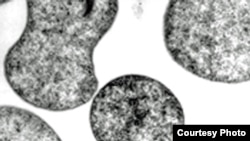Scientists say they have found a way to convert carbon dioxide or CO2 - a greenhouse gas that’s a primary driver of global warming - directly into a biofuel that might someday provide an alternative to climate-changing fossil fuels. Researchers say the conversion relies on an unusual microbe.
The microorganism - a bacterium named Pyrococcus furiosus or “rushing fireball” - was discovered in 1986 on the Mediterranean Sea floor off southern Italy, feeding on carbohydrates in the super-heated, acidic ocean waters surrounding undersea volcanic vents. The find surprised scientists because at the time, no one knew that living organisms could thrive in the dark,100-plus-degree Celsius waters.
Researcher Michael Adams and colleagues at the University of Georgia in Athens, along with scientists at North Carolina State University in Raleigh, were intrigued by the bacterium's chemical processing ability. They genetically modified it so the microbe could feed directly on carbon dioxide gas, and do so at much lower temperatures than its original sea-floor habitat.
Next, researchers added hydrogen gas as an energy source and made further genetic modifications to the microbe that allowed it to generate butanol, a biofuel that burns much like a conventional fossil fuel.
Adams says biofuel production from the marine microbes eliminates the step of extracting such fuel from plants, such as corn and sugar cane. These plants use sunlight to produce sugars, which must then be fermented into ethanol.
“When we say we’re sort of cutting out the middle man, here we’re converting CO2 or carbon dioxide directly into biofuel," said Adams. "But you still need a source of energy. As I said the plant uses light. Our source of energy is hydrogen gas.”
The main source of hydrogen is natural gas, another fossil fuel. But the technology, according to Adams, would be carbon neutral in terms of its environmental impact.
“We would take CO2 from the atmosphere, make biofuel which would then be used and converted back to CO2," he said. "But again the caveat is that we are using hydrogen as an energy source and that energy source has to come from somewhere. And as I say at this point in time, the best source of hydrogen would be natural gas.”
Adams believes the microbe-generated butanol has the potential to replace carbon dioxide-emitting fossil fuels such as oil, gasoline and coal.
He envisions harvesting vast amounts of CO2 from the atmosphere and processing it along with hydrogen in large reactor systems to produce enough butanol for large-scale energy use.
Funding for the research was provided by the U.S. Department of Energy. An article describing the microbial conversion of carbon dioxide into biofuel is published in The Proceedings of the National Academy of Sciences.
The microorganism - a bacterium named Pyrococcus furiosus or “rushing fireball” - was discovered in 1986 on the Mediterranean Sea floor off southern Italy, feeding on carbohydrates in the super-heated, acidic ocean waters surrounding undersea volcanic vents. The find surprised scientists because at the time, no one knew that living organisms could thrive in the dark,100-plus-degree Celsius waters.
Researcher Michael Adams and colleagues at the University of Georgia in Athens, along with scientists at North Carolina State University in Raleigh, were intrigued by the bacterium's chemical processing ability. They genetically modified it so the microbe could feed directly on carbon dioxide gas, and do so at much lower temperatures than its original sea-floor habitat.
Next, researchers added hydrogen gas as an energy source and made further genetic modifications to the microbe that allowed it to generate butanol, a biofuel that burns much like a conventional fossil fuel.
Adams says biofuel production from the marine microbes eliminates the step of extracting such fuel from plants, such as corn and sugar cane. These plants use sunlight to produce sugars, which must then be fermented into ethanol.
“When we say we’re sort of cutting out the middle man, here we’re converting CO2 or carbon dioxide directly into biofuel," said Adams. "But you still need a source of energy. As I said the plant uses light. Our source of energy is hydrogen gas.”
The main source of hydrogen is natural gas, another fossil fuel. But the technology, according to Adams, would be carbon neutral in terms of its environmental impact.
“We would take CO2 from the atmosphere, make biofuel which would then be used and converted back to CO2," he said. "But again the caveat is that we are using hydrogen as an energy source and that energy source has to come from somewhere. And as I say at this point in time, the best source of hydrogen would be natural gas.”
Adams believes the microbe-generated butanol has the potential to replace carbon dioxide-emitting fossil fuels such as oil, gasoline and coal.
He envisions harvesting vast amounts of CO2 from the atmosphere and processing it along with hydrogen in large reactor systems to produce enough butanol for large-scale energy use.
Funding for the research was provided by the U.S. Department of Energy. An article describing the microbial conversion of carbon dioxide into biofuel is published in The Proceedings of the National Academy of Sciences.







